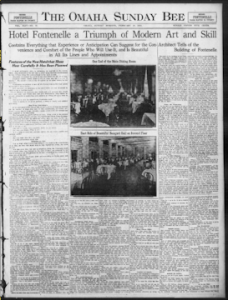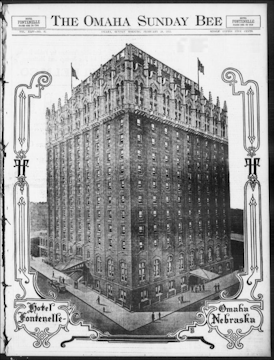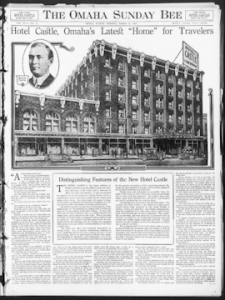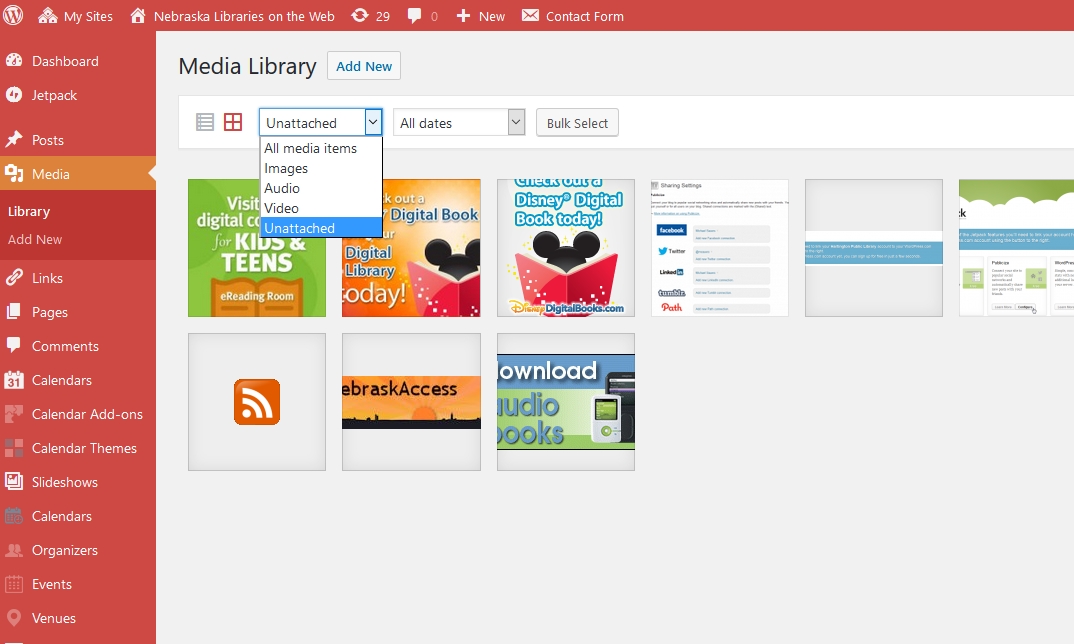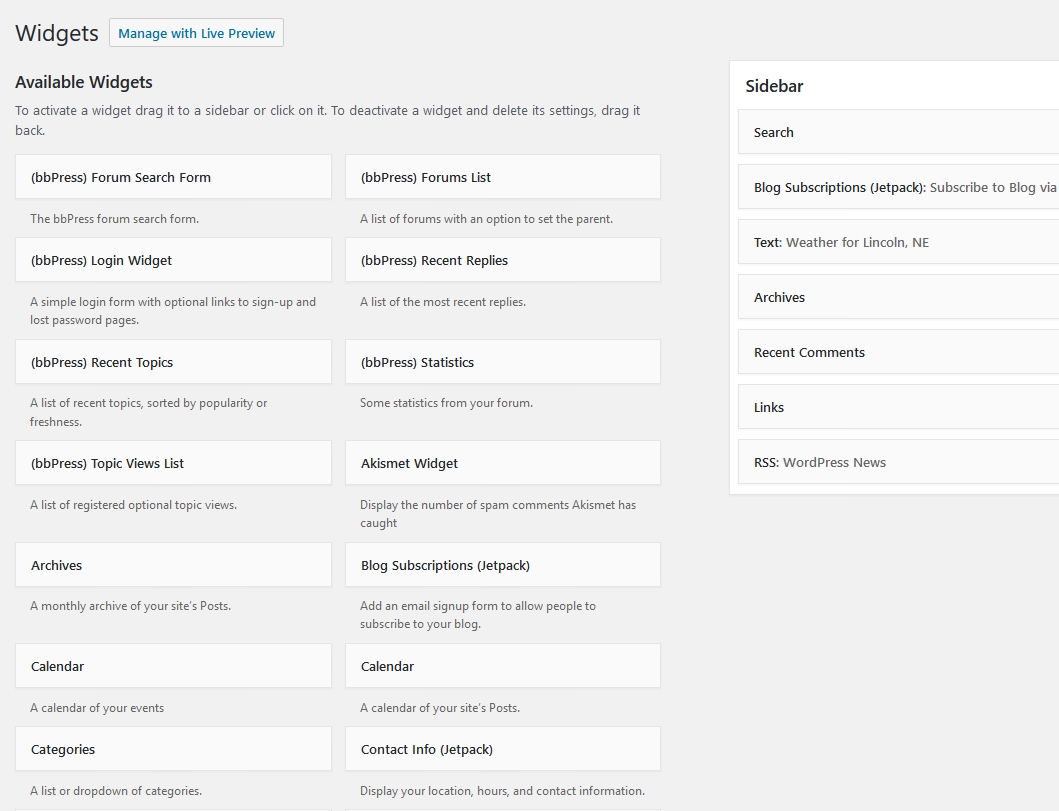Search the Blog
Categories
- Books & Reading
- Broadband Buzz
- Census
- Education & Training
- General
- Grants
- Information Resources
- Library Management
- Nebraska Center for the Book
- Nebraska Libraries on the Web
- Nebraska Memories
- Now hiring @ your library
- Preservation
- Pretty Sweet Tech
- Programming
- Public Library Boards of Trustees
- Public Relations
- Talking Book & Braille Service (TBBS)
- Technology
- Uncategorized
- What's Up Doc / Govdocs
- Youth Services
Archives
Subscribe
Category Archives: Technology
NCompass Live: Under the Microscope: Science at the Library
 Join us for next week’s NCompass Live, ‘Under the Microscope: Science at the Library’, on Wednesday, Dec. 21, 10:00-11:00 am Central Time.
Join us for next week’s NCompass Live, ‘Under the Microscope: Science at the Library’, on Wednesday, Dec. 21, 10:00-11:00 am Central Time.
Valley Public Library was awarded one of the Nebraska Library Commission Youth Grants for Excellence for two microscope kits that would be made available for circulation and would be used in programming for youth and families. The presentation will include background information on our science station that led to the idea for the kits. Descriptions of projects and programs that have been successful will be presented along with potential for future programming and outreach.
Presenters: Claire Bushong, Director, and Gary Brown, Volunteer, Valley (NE) Public Library.
Upcoming NCompass Live events:
- Dec. 28 – Best New Teen Books of 2016
- Jan. 4, 2017 – Begin With Books: An Early Literacy Partnership
- Jan, 11, 2017 – Library Improvement Grants for 2017
For more information, to register for NCompass Live, or to listen to recordings of past events, go to the NCompass Live webpage.
NCompass Live is broadcast live every Wednesday from 10am – 11am Central Time. Convert to your time zone on the Official U.S. Time website. The show is presented online using the GoToWebinar online meeting service. Before you attend a session, please see the NLC Online Sessions webpage for detailed information about GoToWebinar, including system requirements, firewall permissions, and equipment requirements for computer speakers and microphones.
Posted in Education & Training, Grants, Technology
Leave a comment
Library Improvement Grants Now Available for 2017
Library Improvement Grants Now Available for 2017
The 2017 Library Improvement Grants, funded by the Institute of Museum and Library Services (IMLS) from Library Services and Technology Act (LSTA) grant monies, are now available. Nebraska accredited public libraries and certain state-run institutional libraries are eligible to apply for these competitive grants to help facilitate growth and development of library programs and services by supplementing local funding with federal funds designated for these purposes.
In keeping with the goals of the Library Services and Technology Act, the Library Improvement Grants are intended to help libraries meet the goals of the Nebraska Library Commission’s LSTA Five-Year Plan 2013 – 2017. To be funded projects must meet one or more of specific LSTA Purposes listed at the following link. Funding to help libraries join the statewide Pioneer Consortium will receive priority consideration as grant applications are evaluated.
Other requirements include a 25% local match. At least 10% of this match must be in cash. Federal LSTA grants involve meeting certain other requirements which are outlined at the link above and in grant agreement documents for approved projects. The minimum grant amount is $500.
Libraries submitting grant applications will notice that the application form has been changed quite a bit from those used in the past. However, the only changes made from last year’s grant form are the addition of spaces for an Executive Summary of the grant and for an explanation of budget amounts proposed. The changes made on last year’s and this year’s grant form meet federal reporting guidelines which will allow IMLS to present cogent and cohesive reports on the use of federal LSTA monies to Congress as part of its efforts in support of continuing this funding for library services nationwide.
NOTE: Availability of federal Library Services and Technology Act (LSTA) grant monies for the Library Improvement Grants are contingent upon LSTA funding and federal action on appropriations not yet determined for the current federal fiscal year. This means that the Commission will need to wait until decisions have been made at the national level to know if these Library Improvement Grants can be funded. We do not know the dates these decisions will be made.
This link will take you directly to the grant application form.
Pertinent dates to remember:
• December 6, 2016 – Application form available
• January 24, 2017 – Applications due by 11:59 PM Central Time
• February 14, 2017 – Grant recipients announced
NOTE: For more information be sure to tune in at 10 am CT (9 am MT) for the NCompass Live session on Wednesday, January 11, 2017 for the “Library Improvement Grants for 2017” session.
If you have any questions, please feel free to contact me at the Commission:
Richard Miller
Nebraska Library Commission
The Atrium, Suite 120
1200 N Street
Lincoln, NE 68508-2023
800-307-2665 or 402-471-3175
Posted in Grants, Programming, Technology, Uncategorized
Leave a comment
NCompass Live: Technology Classes at Your Library

Join us for next week’s NCompass Live, ‘Technology Classes at Your Library’, on Wednesday, Dec. 7, 10:00-11:00 am Central Time.
In the past three years, the Iowa City Public Library has tripled their patron involvement in technology classes taught by library staff, without increasing staff or budget. Technology is an ever changing landscape and classes are a great way to help patrons become savvier technology users. Learn how to grow interest in your library’s technology courses with strategies for assessment, marketing, and curriculum development.
Presenter: Jen Eilers, Library Assistant, Iowa City Public Library. Jen organizes and coordinates a team of librarians who teach 4-5 classes a month to adult learners. The classes focus on technology and information literacy skills for the Iowa City Community. She also staffs the information desk and problem solves various patron technology issues through the library’s drop-in tech zone.
Upcoming NCompass Live events:
- Dec. 14 – Best New Children’s Books of 2016
- Dec. 21 – Under the Microscope: Science at the Library
- Dec. 28 – Best New Teen Books of 2016
- Jan. 4, 2017 – Begin With Books: An Early Literacy Partnership
For more information, to register for NCompass Live, or to listen to recordings of past events, go to the NCompass Live webpage.
NCompass Live is broadcast live every Wednesday from 10am – 11am Central Time. Convert to your time zone on the Official U.S. Time website. The show is presented online using the GoToWebinar online meeting service. Before you attend a session, please see the NLC Online Sessions webpage for detailed information about GoToWebinar, including system requirements, firewall permissions, and equipment requirements for computer speakers and microphones.
Posted in Education & Training, Technology
Leave a comment
Call for Speakers for the 2017 Big Talk From Small Libraries online conference
The Call for Speakers for Big Talk From Small Libraries 2017 is now open! This free one-day online conference is aimed at librarians from small libraries; the smaller the better. Small libraries of all types – public, academic, school, museum, special, etc. – are encouraged to submit a proposal.
Do you offer a service or program at your small library that other librarians might like to hear about? Have you implemented a new (or old) technology, hosted an event, partnered with others in your community, or just done something really cool? The Big Talk From Small Libraries online conference gives you the opportunity to share what you’ve done, while learning what your colleagues in other small libraries are doing. Here are some possible topics to get you thinking:
- Unique Libraries
- Special Collections
- New buildings
- Fundraising
- Improved Workflows
- Staff Development
- Advocacy Efforts
- Community Partnerships
- That great thing you’re doing at your library!
For Big Talk From Small Libraries 2017, we’re looking for seven 50-minute presentations 7and five 10-minute “lightning round” presentations.
Big Talk From Small Libraries 2017 will be held on Friday, February 24, 2017 between 8:45 a.m. and 5:00 p.m. (CT) via the GoToWebinar online meeting service. Speakers will be able to present their programs from their own desktops. The schedule will accommodate speakers’ time-zones.
If you are interested in presenting, please submit your proposal by Friday, January 13, 2017. Speakers from libraries serving fewer than 10,000 people will be preferred, but presentations from libraries with larger service populations will be considered.
Join the Nebraska Dewey Group Purchase
This is a good time of year to remind Nebraska librarians that they can save money on the web and print versions of the Dewey Decimal Classification (DDC) system by participating in the Nebraska Dewey Group Purchase!
Dewey on the Web
Enjoy web-based access to an enhanced version of the Dewey Decimal Classification (DDC) database through WebDewey. WebDewey includes all content from the print edition and features:
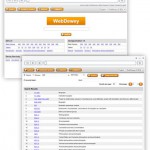 regular updates (new developments, new built numbers and additional electronic index terms)
regular updates (new developments, new built numbers and additional electronic index terms)- an easy-to-navigate, simple user interface that is suitable for the novice as well as the power user
- BISAC-to-DDC mappings
Our next WebDewey Group annual subscription term will begin on January 1, 2017 and run through December 31, 2017. Libraries may join the Group at any time. Mid-term subscriptions will be prorated. Orders must be received by the 15th of the month for a start date of the 1st of the following month.
If your library is interested in subscribing to WebDewey, you will find Pricing information on the online WebDewey Order Form.
To see WebDewey in action, try the WebDewey 2.0: An Overview tutorial.
Dewey in Print
The Nebraska Dewey Group includes the print versions of the Abridged Edition 15 (1 volume) and the 23rd edition of the unabridged Dewey Decimal Classification (4 volumes).
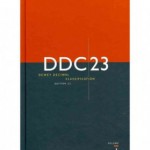 OCLC is offering group participants 10% off of the original list price on the DDC in print.
OCLC is offering group participants 10% off of the original list price on the DDC in print.
If your library is interested in ordering the DDC in print, you will find pricing information on the online Book Order Form.
For more information about the DDC, please visit Dewey Services.
If you have any questions about these Dewey products or the Nebraska Group, please contact Susan Knisely, 402-471-3849 or 800-307-2665.
NOTE: OCLC Membership is NOT required to purchase Dewey products.
Posted in General, Library Management, Technology, Uncategorized
Leave a comment
NCompass Live: Computer Networking for Librarians

Join us for next week’s NCompass Live, “Computer Networking for Librarians”, on Wednesday, Nov. 16, 10:00-11:00 am Central Time.
Your computer network silently keeps your library running every day, but how much do you really know about it? Join Chris as he talks about how the network functions and the basic components that make it tick. We’ll review routers, switches, firewalls, and how everything works together, plus some tips on what to do if there’s a problem. Presented in a fun, accessible format, this session is introductory-level, and perfect for beginners.
Presenter: Chris Brown is assistant library director at the Pella (IA) Public Library. Chris has worked for more than eight years in public libraries as an IT professional, including managing the IT for a seven-branch library system. He recently completed work on the book Crash Course in Technology Planning, available now from Libraries Unlimited.
Upcoming NCompass Live events:
- Nov. 23 – A Librarian Walks Into a Bar….
- Nov. 30 – Reader of the Week
- Dec. 7 – Technology Classes at Your Library
- Dec. 14 – Best New Children’s Books of 2016
- Dec. 28 – Best New Teen Books of 2016
For more information, to register for NCompass Live, or to listen to recordings of past events, go to the NCompass Live webpage.
NCompass Live is broadcast live every Wednesday from 10am – 11am Central Time. Convert to your time zone on the Official U.S. Time website. The show is presented online using the GoToWebinar online meeting service. Before you attend a session, please see the NLC Online Sessions webpage for detailed information about GoToWebinar, including system requirements, firewall permissions, and equipment requirements for computer speakers and microphones.
Posted in Education & Training, Technology
Leave a comment
NCompass Live: Do Space: Omaha’s Digital Library
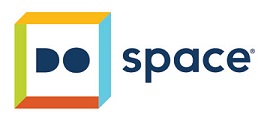 Join us for next week’s NCompass Live, “Do Space: Omaha’s Digital Library”, on Wednesday, Nov. 9, 10:00-11:00 am Central Time.
Join us for next week’s NCompass Live, “Do Space: Omaha’s Digital Library”, on Wednesday, Nov. 9, 10:00-11:00 am Central Time.
Do Space is one year old this week! Join Executive Director Rebecca Stavick to learn more about this one-of-a-kind concept in Omaha, Nebraska: it’s a community technology library, a digital workshop, and an innovation playground filled with new opportunities to learn, grow, explore and create.
Upcoming NCompass Live events:

- Nov. 16 – Computer Networking for Librarians
- Nov. 23 – A Librarian Walks Into a Bar….
- Nov. 30 – Reader of the Week
- Dec. 7 – Technology Classes at Your Library
- Dec. 28 – Best New Teen Books of 2016
For more information, to register for NCompass Live, or to listen to recordings of past events, go to the NCompass Live webpage.
NCompass Live is broadcast live every Wednesday from 10am – 11am Central Time. Convert to your time zone on the Official U.S. Time website. The show is presented online using the GoToWebinar online meeting service. Before you attend a session, please see the NLC Online Sessions webpage for detailed information about GoToWebinar, including system requirements, firewall permissions, and equipment requirements for computer speakers and microphones.
Posted in Education & Training, Technology
Leave a comment
Department of Insurance Releases Health Insurance Rates Ahead of Open Enrollment
 In an effort to help Nebraska consumers navigate through open enrollment, the Department of Insurance has developed the 2017 Health Plan and Rate Preview tool. This powerful tool will help aid consumers in their search for an affordable health plan. The 2017 Health Plan and Rate Preview tool is user-friendly and lets consumers see the true cost of a health plan based on where they live, their age and if they use tobacco products. “With rising healthcare premiums and confusion over health insurance plans, I hope that individuals use this tool to research which plans best fit their current situation,” said Director of Insurance Bruce Ramge.
In an effort to help Nebraska consumers navigate through open enrollment, the Department of Insurance has developed the 2017 Health Plan and Rate Preview tool. This powerful tool will help aid consumers in their search for an affordable health plan. The 2017 Health Plan and Rate Preview tool is user-friendly and lets consumers see the true cost of a health plan based on where they live, their age and if they use tobacco products. “With rising healthcare premiums and confusion over health insurance plans, I hope that individuals use this tool to research which plans best fit their current situation,” said Director of Insurance Bruce Ramge.
The 2017 Health Plan and Rate Preview tool not only gives plan information for individual health insurance plans but also gives consumers the ability to look at small group plan rates. The Department of Insurance hopes that the 2017 rate information will help consumers be better informed about the health insurance plan choices that they have available.
The Department of Insurance would like to remind consumers that open enrollment begins on November 1, 2016, and ends on January 31, 2017. Consumers need to enroll in a health plan by December 15, 2016, to have continuous insurance coverage. To find out more about the Affordable Care Act and open enrollment, go to http://nehealthinsuranceinfo.gov/
*Released by Nebraska Department of Insurance, 10/25/2016
“The establishment of the town of Hastings was an afterthought…”
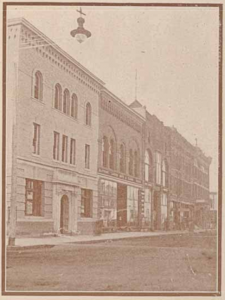
First National Bank – 2nd Street, West from Hastings Ave. As you can see in Google Street view, this building is still standing today.
“The establishment of the town of Hastings was an afterthought with the men who settled upon the three homesteads which formed the original parts of town.” I don’t know if that is true but that is what Henry G. Smith wrote in the Book of Hastings : a sketch of the town with illustrations. This book, published in 1906, is available in Nebraska Memories.
The Book of Hastings tells the history of the area starting in 1869. In 1873, the Hastings Town Company (page 6) was formed to develop the town of Hastings. On April 20, 1874, Hastings was declared an incorporated town.
Browsing this book, I learned a lot about the history of Hastings and the surrounding area. The book does not have a table of contents or an index, so I wanted to highlight some of the information available in this book.
- A number of railroads had service to or through Hastings over the years including the St. Joe & Grand Island, Burlington & Fremont, Elkhorn & Missouri Valley. (page 18)
- Juniata was selected as the county seat of Adams County in December 1871. Not everyone was happy with this. For years, folks fought to move the county seat to Hastings while others fought to keep it in Juniata.
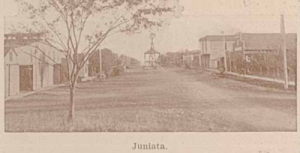
Juniata (page 81)
The group supporting Juniata won the 1875 election but lost the 1877 election. They were not happy with the loss and contested the vote. The issue was finally settled by Judge Gaslin. (page 22)
- A fire in 1879 destroyed 33 buildings in the Hastings business district. Many of the wooden buildings that burned were replaced with brick buildings. Later that year the Burlington depot was destroyed to cover up a murder. Fires in 1881, 1890, and 1905 also destroyed many businesses in town. (page 28)
- At the time this book was written, there were 18 church organizations in Hastings. A brief history of each organization is included. (page 40)
- The Hastings Library opened in January 1888. It was run by the Library Mite Society until it was taken over by the city government. In the spring of 1905 the new Carnegie building was completed. The library contained about 6,000 volumes. Miss Mabel Stone was the librarian. (page 46)
- Hastings residents started discussing the possibility of building a college in 1873 however, Hastings College did not become a reality until 1882. J. J. H. Hewitt was the first student to graduate in 1887. Dr. W. F. Ringland was the president of the college for the first 15 years. (page 70)
- Starting on page 81 you can find lists of many of the towns first officials including the mayor and councilmen.
- Towards the end of the book you will find a list of “Personal Sketches of Early Settlers” (page 95) followed by a list of businesses titled “Among the Business Houses” (page 103).
- The book is also full of pictures of houses however; most of them are only labeled with the name of the current resident.
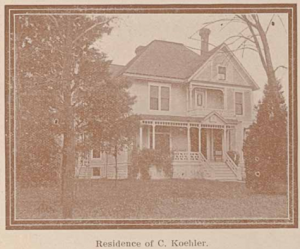
Residence of C. Koehler. (page 54)
I hope you take a few minutes to learn more about Hastings by looking at the Book of Hastings : a sketch of the town with illustrations.
Visit Nebraska Memories to search for or browse through many more historical images digitized from photographs, negatives, postcards, maps, lantern slides, books and other materials.
Nebraska Memories is a cooperative project to digitize Nebraska-related historical and cultural heritage materials and make them available to researchers of all ages via the Internet. Nebraska Memories is brought to you by the Nebraska Library Commission. If your institution is interested in participating in Nebraska Memories, see http://nlc.nebraska.gov/nebraskamemories/participation.aspx for more information, contact Devra Dragos, Technology & Access Services Director.
Free Webinar! Serving Older Adults in a Changing World
 Date: November 8, 2016
Date: November 8, 2016
Time : 3:00-4:00 EST, 2:00-3:00 CST
With longer life expectancy and increasing diversity, older adults are reinventing aging and changing perceptions of their demographic. It’s time to rethink how our libraries serve this important and growing segment of our patron base. This webinar will focus on trends and impacts of the aging population, and will share creative strategies for library staff to meet the evolving needs of older adults in a changing world.
King County Library System was recently recognized by Urban Libraries Council as a 2016 Top Innovator for their work with older adults. Congratulations!
Presented by: Wendy Pender, Older Adults Project Specialist, King County Library System (WA)
Related Resources and Links:
- King County Library System’s 50+ page
- Pew Research on Older Adults
- National Council on Aging
- White House Conference on Aging
- Aging.gov
- Census.gov (Facts on older Americans)
NCompass Live: Organizing a Successful Comic/Maker Con at Your Library

Join us for next week’s NCompass Live, “Organizing a Successful Comic/Maker Con at Your Library”, on Wednesday, Oct. 26, 10:00-11:00 am Central Time.
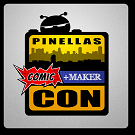 Comic Cons are organized conventions for fans of comic books, anime, manga, science fiction, cosplay, and more. Maker Cons showcase the maker movement to include 3D printers, robotics, virtual reality, drones, and other emerging technologies that creative people use as tools to innovate. The first annual Mid-Pinellas Comic and Maker Con was organized in less than 6 weeks and with very little money. This event had 3,500 people attend, which was second only to a visit to the St. Petersburg College Seminole campus by President Barack Obama in September 2012! The second year, even with a name change to Pinellas Comic and Maker Con, attendance went up to over 4,000 participants! And, the third year over 5,000! Learn the ins-and-outs including legal, sponsorship, security issues, and much more of organizing a Comic and Maker Con to help highlight your library’s unique collections/services and to have a lot of fun doing it!
Comic Cons are organized conventions for fans of comic books, anime, manga, science fiction, cosplay, and more. Maker Cons showcase the maker movement to include 3D printers, robotics, virtual reality, drones, and other emerging technologies that creative people use as tools to innovate. The first annual Mid-Pinellas Comic and Maker Con was organized in less than 6 weeks and with very little money. This event had 3,500 people attend, which was second only to a visit to the St. Petersburg College Seminole campus by President Barack Obama in September 2012! The second year, even with a name change to Pinellas Comic and Maker Con, attendance went up to over 4,000 participants! And, the third year over 5,000! Learn the ins-and-outs including legal, sponsorship, security issues, and much more of organizing a Comic and Maker Con to help highlight your library’s unique collections/services and to have a lot of fun doing it!
Presenter: Chad Mairn is a librarian, teacher, author, and self-described geek who frequently shares his enthusiasm for ‘all-things technology’ as a speaker at library and technology conferences. He is an Information Services Librarian, Assistant Professor, and manages the Innovation Lab at St. Petersburg College (FL).
Upcoming NCompass Live events:
- Oct. 19 – NO NCOMPASS LIVE THIS WEEK – Enjoy the 2016 NLA/NSLA Annual Conference!
- Oct. 26 – Organizing a Successful Comic/Maker Con at Your Library
- Nov. 2 – 2017 Nebraska Library Internship Grant Program
For more information, to register for NCompass Live, or to listen to recordings of past events, go to the NCompass Live webpage.
NCompass Live is broadcast live every Wednesday from 10am – 11am Central Time. Convert to your time zone on the Official U.S. Time website. The show is presented online using the GoToWebinar online meeting service. Before you attend a session, please see the NLC Online Sessions webpage for detailed information about GoToWebinar, including system requirements, firewall permissions, and equipment requirements for computer speakers and microphones.
‘E-rate: What’s New for 2017?’ Workshops Scheduled
“E-rate: What’s New for 2017?” has been scheduled in locations across the state and online.
What is E-rate? How can my library benefit from E-rate? How do I apply for E-rate?
E-rate is a federal program that provides discounts to schools and libraries on Telecommunications, Internet access, and Internal Connections costs in order to make these services more affordable. There have been some big changes to E-rate since USAC launched the E-Rate Productivity Center(EPC) last year. This new online portal is the main point of entry for all future E-rate interactions. With your organizational account you can now use EPC to file forms, track your application status, communicate with USAC, and more.
What does your library need to know to use this new E-rate portal? In this workshop, Christa (Burns) Porter, Nebraska’s State E-rate Coordinator for Public Libraries, will first cover the basics of the E-rate program and then show you how to access and use your account in EPC to submit your Funding Year 2017 E-rate application.
Dates and locations:
- November 14 – Norfolk, Northeast Community College
- November 15 – Omaha, Public Library, Abrahams Branch
- November 17 – Kearney Public Library
- November 18 – Ogallala Public Library
- November 29 – Lincoln, Nebraska Library Commission
- December 1 – Online, GoToWebinar
To register for any of these sessions, go to the Nebraska Library Commission’s Training & Events Calendar and search for ‘e-rate 2017’.
Star Net Eclipse Webinar Series
 Is Your Library Ready for the Astronomical Event of the Decade?
Is Your Library Ready for the Astronomical Event of the Decade?
Star Net is presenting a series of webinars in preparation for the solar eclipse next year.
Next Webinar: Wednesday, October 19th, 2016 at 11:00 am MT, 12:00 CT, 1:00 ET
On August 21, 2017, we will be treated to the first total eclipse of the Sun visible in the continental U.S. in almost 40 years. The spectacular total eclipse will only be visible in a narrow band about 60 miles across, stretching diagonally across the country from a beach in Oregon to a beach in South Carolina. However, everyone in North America will see a partial solar eclipse, where a big “bite” will be taken out of the Sun.
This will be the first major U.S. eclipse of the Internet age, and most people will need clear reliable information on when and how to observe the eclipse of the Sun safely. Astronomers are hoping libraries will play a key role in getting this information out to their communities. Working with astronomy groups in their communities, they could also be a central place for safe observing.
Get an early start in preparing for this eclipse, how to explain it, how to observe it safely, and what role libraries can play in organizing and informing their communities.
Join us for a 45 minute webinar where you’ll get great information about the eclipse, and be able to ask questions about the role your library can play. Hosts: Dennis Schatz (NSTA, Pacific Science Center), and Andrew Fraknoi (Foothill College; co-author of a new book on eclipse education). Click here for an Eclipse FAQ sheet.
To register, please click here. Password is “star”.
NCompass Live: Circulating the Internet – How to Loan WiFi Hotspots

Join us for next week’s NCompass Live, “Circulating the Internet – How to Loan WiFi Hotspots”, on Wednesday, Oct. 12, 10:00-11:00 am Central Time.
Learn how the Norfolk (NE) Public Library started loaning out WiFi hotspots to patrons in August 2016. Library staff will share their inspiration for starting the program, how they worked through the logistics and policies needed, and what the public reaction has been to the new service.
Presenters: Jessica Chamberlain, Director; Judy Hilkemann, Systems Assistant/Reference Supervisor; and Mike Dittmer, Technology Specialist, Norfolk (NE) Public Library.
Upcoming NCompass Live events:
- Oct. 19 – NO NCOMPASS LIVE THIS WEEK – Enjoy the 2016 NLA/NSLA Annual Conference!
- Oct. 26 – Organizing a Successful Comic/Maker Con at Your Library
- Nov. 2 – 2017 Nebraska Library Internship Grant Program
For more information, to register for NCompass Live, or to listen to recordings of past events, go to the NCompass Live webpage.
NCompass Live is broadcast live every Wednesday from 10am – 11am Central Time. Convert to your time zone on the Official U.S. Time website. The show is presented online using the GoToWebinar online meeting service. Before you attend a session, please see the NLC Online Sessions webpage for detailed information about GoToWebinar, including system requirements, firewall permissions, and equipment requirements for computer speakers and microphones.
Posted in Education & Training, Technology
Leave a comment
NCompass Live: Pokemon GO @ Your Library

Join us for next week’s NCompass Live, “Pokemon GO @ Your Library”, on Wednesday, Sept. 28, 10:00-11:00 am Central Time.
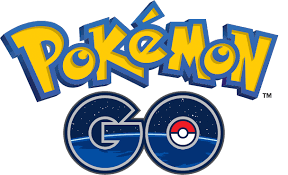 The new augmented reality mobile game, Pokemon GO, has taken the world by storm. If you have no idea what Pokemon is, this session is for you! Liz Hittle, from Scribner (NE) Public Library, will explain how you can help out your patrons who are new to the game and what you can do with Pokemon GO at your library. You just might catch ’em all!
The new augmented reality mobile game, Pokemon GO, has taken the world by storm. If you have no idea what Pokemon is, this session is for you! Liz Hittle, from Scribner (NE) Public Library, will explain how you can help out your patrons who are new to the game and what you can do with Pokemon GO at your library. You just might catch ’em all!
Upcoming NCompass Live events:
- Oct. 12 – Circulating the Internet: How to Loan WiFi Hotspots
- Oct. 19 – NO NCOMPASS LIVE THIS WEEK – ENJOY NLA/NSLA!
- Oct. 26 – Library ComicCon
For more information, to register for NCompass Live, or to listen to recordings of past events, go to the NCompass Live webpage.
NCompass Live is broadcast live every Wednesday from 10am – 11am Central Time. Convert to your time zone on the Official U.S. Time website. The show is presented online using the GoToWebinar online meeting service. Before you attend a session, please see the NLC Online Sessions webpage for detailed information about GoToWebinar, including system requirements, firewall permissions, and equipment requirements for computer speakers and microphones.
Hotel Fontenelle and Hotel Castle
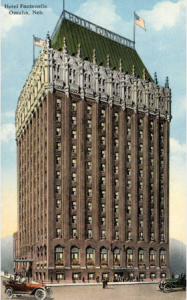 The first images the Hotel Fontenelle and Hotel Castle I saw were those included in Nebraska Memories. I didn’t know anything about the hotels and there wasn’t a lot of information about them included in Nebraska Memories. I decided to do a bit of research hoping to find a few interesting tidbits that I could share with you. I found more than just a few tidbits; I found what I consider to be a research jackpot. The Omaha Daily Bee newspaper did multiple page specials on both hotels when they opened. These special supplements are made up of multiple stories that tell about the hotels. Many of the companies that built, furnished and continued to work with the hotels also had advertisements in the supplements highlighting how they were connected to the hotels. These supplements were fun to read. I learned a lot about each hotel but it was also amusing to see what things were important to write about in 1915.
The first images the Hotel Fontenelle and Hotel Castle I saw were those included in Nebraska Memories. I didn’t know anything about the hotels and there wasn’t a lot of information about them included in Nebraska Memories. I decided to do a bit of research hoping to find a few interesting tidbits that I could share with you. I found more than just a few tidbits; I found what I consider to be a research jackpot. The Omaha Daily Bee newspaper did multiple page specials on both hotels when they opened. These special supplements are made up of multiple stories that tell about the hotels. Many of the companies that built, furnished and continued to work with the hotels also had advertisements in the supplements highlighting how they were connected to the hotels. These supplements were fun to read. I learned a lot about each hotel but it was also amusing to see what things were important to write about in 1915.
The Hotel Fontenelle opened in February 1915 on the corner of 18th and Douglas streets. It operated as a hotel until 1971 and was razed in 1983. The supplement covering the Hotel Fontenelle in the Omaha Daily Bee was published on February 28, 1915. The supplement is 15 pages long and was published in two sections. Both parts contain photos of the inside of the hotel.
Here are a few things in the article that caught my attention for one reason or another.
- “There are really sixteen stories in the Fontenelle – above the street. And there are two stories, very busy stories below the street. Total height, eighteen stories.”
- The architecture is Gothic. The first 10 stories are dark brick, above that is white tile and “the building design is of fretted and gabled French chateau style, with gabled roof painted a pleasing green.”
- The land cost $215,000.
- The land and building were owned by the Douglas Hotel Company. The supplement includes a list of officers and directors of the Douglas Hotel
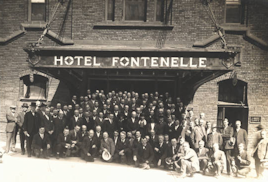 Company. The Interstate Hotel Company of Nebraska leased the hotel and ran it.
Company. The Interstate Hotel Company of Nebraska leased the hotel and ran it. - William R. Burbank was the director general of the hotel. Abraham Burbank was the managing director.
- The hotel has 350 guest rooms. The room rates varied depending on if they faced the street and the size and configuration of the room. The cheapest room listed was $2 a day while a corner suite that had a bedroom, bathroom and sitting room was $10 a day.
- “Sample rooms will rent at $2.50 up, according to size and location.” Traveling salesmen stayed at the hotel and used a sample room to display their products. The
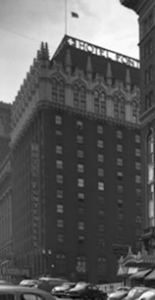 sample rooms were located on the tenth and eleventh floors. The rooms had thick carpeting, telephones and private toilet and bath rooms.
sample rooms were located on the tenth and eleventh floors. The rooms had thick carpeting, telephones and private toilet and bath rooms. - All of the rooms in the hotel had a telephone. Telephones were also placed in other locations such as the kitchen, barbershop, lobby and elevator. A very long article explains the 63 miles of telephone wire used and the switchboard could serve a town of about 3,000 people.
- Every room had “ice water on tap”. The water was “cooled to a temperature of forty degrees by ammonia coils” before being distributed through the building.
- The L. G. Doup Co. of Omaha provided the box springs and mattresses for the hotel. The mattresses were of the “very best quality — the hair used in the mattresses is long curled horse hair of the quality known as drawings…”
- “Big Electric Signs on top of New Hotel” – A short articles talks about the importance of the electric signs. “It is so built that it harmonizes with the
 gable roof of the French chateau style of architecture.”
gable roof of the French chateau style of architecture.” - Included in the supplement are the floor plans for the ground floor and the main floor.
- “Hotel on Cow Stable Site” This column talks about the land the hotel was built on and how it was “far remote in the outskirts of a frontier country village fifty year ago; today the location of Omaha’s $1,000,000 modern and palatial hotel…”
- “Hotel Has Its Own Laundry” – I was surprised to read that the laundry was located on the 13th floor. “This is the only original motor driven laundry in Omaha. … big “extractors,” which turn on their vertical axes at a speed of a thousand revolutions a minute. These are for drying the wash. They remove the moisture by centrifugal force instead of by the slow and primitive process of drying.”
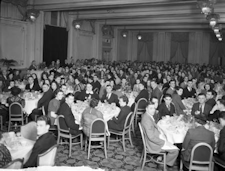
- Thomas R. Kimball was the architect for the hotel. According to the article, he was also the architect for the S. Cecelia’s cathedral, the Burlington station, designed the city library and the Methodist hospital.
- I’ve never heard of a telautograph but the Fontenelle had one. “A telautograph is an instrument that will reproduce your handwriting perfectly at a distance.”
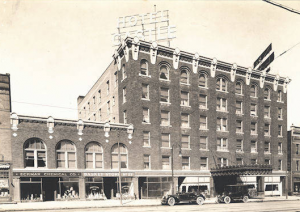 The Hotel Castle was located on corner of 16th and Jones Street and opened in March 1915. The main building was six stories high. The hotel had 150 rooms. All of the rooms had a toilet and running hot and cold water. One hundred of them also had private baths. Rooms rented for $1.25-$2 a day. Attached to the hotel is a two-story building referred to as the annex. The 50×80 feet convention hall or ballroom is located on the second floor of the annex.
The Hotel Castle was located on corner of 16th and Jones Street and opened in March 1915. The main building was six stories high. The hotel had 150 rooms. All of the rooms had a toilet and running hot and cold water. One hundred of them also had private baths. Rooms rented for $1.25-$2 a day. Attached to the hotel is a two-story building referred to as the annex. The 50×80 feet convention hall or ballroom is located on the second floor of the annex.
The special supplement about the Hotel Castle was published on March 21, 1915 in the Omaha Daily Bee. Here are some of things I found interesting about the Hotel Castle.
- “The Hotel Castle is absolutely fireproof. From basement to proof [sic] there is hardly a splinter in the construction that can be consumed by fire. The doors of the rooms are about the only inflamable things, the rest being concrete and marble.” Multiple times in the article, fireproofing is mentioned. This may seem odd at first but keep in mind that in 1913 a fire destroyed the Dewey Hotel killing around 20 people. If you would like to read about this fire there is an article about it in the Mach 1, 1913 issue of the Omaha Daily Bee.
- “even the smallest rooms have three lights,…and a third at the head of the bed so that guests can enjoy the luxury of reading in bed.”
- Miss Clara Fry was proprietor of the cigar stand. Miss Fry also owned a cigar stand in the Plains Hotel in Cheyenne Wyo.

- “Vinegar, pickles, olives, sauerkraut, ketchup and the like will be supplied to the new Castle by Haarmann Vinegar and Pickle Company…”
- The supplement contains a picture of a guest room and a bathroom and other rooms in the hotel.
- Yourex silverware was used at the hotel.
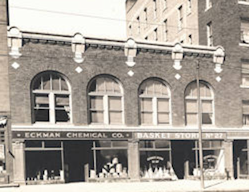
- “The Eckman Chemical Company was the first outside concern to rent one of the store buildings facing Sixteenth Street on the ground floor of the Castle.” According to their ad “If you have sick hogs, try Eckman’s special treatment for sick hogs.”
- If you need a laugh, I’d suggest reading the article “Some Guests to be Barred – Messrs. Rat, Mouse, and Bug and Their Families to Find No Homes Here.” It is a rather long article that tells the story of how Mr. Rat and his family were not able to find a place to live in the new Castle Hotel.
I hope you enjoyed learning about the Hotel Fontenelle and Hotel Castle.
Visit Nebraska Memories to search for or browse through many more historical images digitized from photographs, negatives, postcards, maps, lantern slides, books and other materials.
Nebraska Memories is a cooperative project to digitize Nebraska-related historical and cultural heritage materials and make them available to researchers of all ages via the Internet. Nebraska Memories is brought to you by the Nebraska Library Commission. If your institution is interested in participating in Nebraska Memories, see http://nlc.nebraska.gov/nebraskamemories/participation.aspx for more information, contact Devra Dragos, Technology & Access Services Director.
Posted in General, Nebraska Memories, Technology
1 Comment
Free Webinar! New STAR_Net Resources for your Library
 Date: Wednesday, September 21
Date: Wednesday, September 21
Time: 1:00-1:30pm MDT (2:00-2:30 CDT, 3:00-3:30 EDT)
Join Anne Holland (Community Engagement Manager at the Space Science Institute) for a “Grand Opening” of the two new websites.
You’ll receive a tour of the new features and resources (available at www.starnetlibraries.org and clearinghouse.starnetlibraries.org) as well as have an opportunity to suggest new features and content.
You’ll also receive information on how to register your library for the 2017 Solar Eclipse, and get some free swag! We will keep this webinar to 30 minutes. See you there!
To register, please click here. Password is “star”.
NLC Staff: Meet Craig Lefteroff
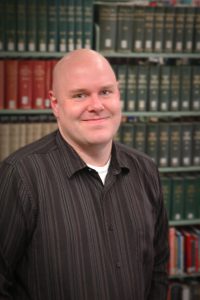 Meet Craig Lefteroff, who joined the Nebraska Library Commission as our Technology Innovation Librarian a year ago this month. Craig was born in Vicksburg, Mississippi and attended college at Delta State University, in Cleveland, Mississippi, graduating with a BA in English. After graduation, Craig taught English and speech for one year in a Mississippi Delta town with one store and a prison. This experience encouraged Craig to seek new employment, so he moved to Versailles (pronounced ver-say-elles), Kentucky, where he cleaned computers for Walmart. Next up was a job as an accountant for a Holiday Inn in Lexington, Kentucky. This job afforded him some flexibility so, affirming his love for books and literature, he enrolled in library school at the University of Kentucky.
Meet Craig Lefteroff, who joined the Nebraska Library Commission as our Technology Innovation Librarian a year ago this month. Craig was born in Vicksburg, Mississippi and attended college at Delta State University, in Cleveland, Mississippi, graduating with a BA in English. After graduation, Craig taught English and speech for one year in a Mississippi Delta town with one store and a prison. This experience encouraged Craig to seek new employment, so he moved to Versailles (pronounced ver-say-elles), Kentucky, where he cleaned computers for Walmart. Next up was a job as an accountant for a Holiday Inn in Lexington, Kentucky. This job afforded him some flexibility so, affirming his love for books and literature, he enrolled in library school at the University of Kentucky.
Craig’s first professional library job was as a reference librarian at St. Tammany Parish Library north of Lake Pontchartrain after Hurricane Katrina. A tipping point occurred during this chapter of Craig’s life and it was time to try living closer if not north of the Mason-Dixon Line. To fill a job title of Reference and Electronics Librarian, Craig moved to West Virginia to work for the Kanawha City Public Library where he lived at the top of a hill. When Craig was selected by the Nebraska Library Commission, it was a priority to be able to walk to work as this was never a possibility in Elkview.
It is typical for librarians to have eclectic interests and Craig fits this description. He surrounds himself with a variety of people and enjoys movies, music, and reading. Some of Craig’s favorite authors are Thomas Hardy, George Elliot, Herman Melville, Cormac McCarthy, and Mary Roach. A book that Craig has read at least five times is Stoner by John Williams owing to the theme of a young man growing up in the south who falls in love with literature. If money were no issue, he would spend his time reading and traveling first to Italy. When asked what other profession he would like to practice, Craig would be a writer and when I asked him to comment on his associations about his workplace, he responded: food day.
We’re grateful Craig has made the Midwest his home and is willing to share his skills and interests with those of us in Nebraska libraries.
Digitized and Free to Read Online : Archive of 6,000 Historical Children’s Books
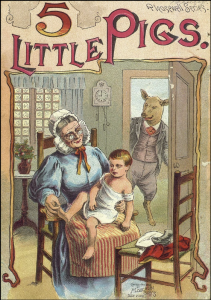 We can learn much about how a historical period viewed the abilities of its children by studying its children’s literature. Occupying a space somewhere between the purely didactic and the nonsensical, most children’s books published in the past few hundred years have attempted to find a line between the two poles, seeking a balance between entertainment and instruction. However, that line seems to move closer to one pole or another depending on the prevailing cultural sentiments of the time. And the very fact that children’s books were hardly published at all before the early 18th century tells us a lot about when and how modern ideas of childhood as a separate category of existence began.
We can learn much about how a historical period viewed the abilities of its children by studying its children’s literature. Occupying a space somewhere between the purely didactic and the nonsensical, most children’s books published in the past few hundred years have attempted to find a line between the two poles, seeking a balance between entertainment and instruction. However, that line seems to move closer to one pole or another depending on the prevailing cultural sentiments of the time. And the very fact that children’s books were hardly published at all before the early 18th century tells us a lot about when and how modern ideas of childhood as a separate category of existence began.
“By the end of the 18th century,” writes Newcastle University professor M.O. Grenby, 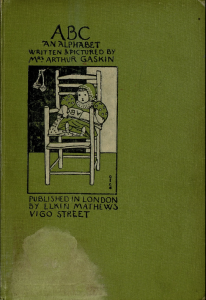 “children’s literature was a flourishing, separate and secure part of the publishing industry in Britain.” The trend accelerated rapidly and has never ceased—children’s and young adult books now drive sales in publishing (with 80% of YA books bought by grown-ups for themselves). Grenby notes that “the reasons for this sudden rise of children’s literature” and its rapid expansion into a booming market by the early 1800s “have never been fully explained.” We are free to speculate about the social and pedagogical winds that pushed this historical change.
“children’s literature was a flourishing, separate and secure part of the publishing industry in Britain.” The trend accelerated rapidly and has never ceased—children’s and young adult books now drive sales in publishing (with 80% of YA books bought by grown-ups for themselves). Grenby notes that “the reasons for this sudden rise of children’s literature” and its rapid expansion into a booming market by the early 1800s “have never been fully explained.” We are free to speculate about the social and pedagogical winds that pushed this historical change.
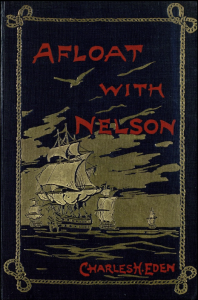 Or we might do so, at least, by examining the children’s literature of the Victorian era, perhaps the most innovative and diverse period for children’s literature thus far by the standards of the time. And we can do so most thoroughly by surveying the thousands of mid- to late 19th century titles at the University of Florida’s Baldwin Library of Historical Children’s Literature. Their digitized collection currently holds over 6,000 books free to read online from cover to cover, allowing you to get a sense of what adults in Britain and the U.S. wanted children to know and believe.
Or we might do so, at least, by examining the children’s literature of the Victorian era, perhaps the most innovative and diverse period for children’s literature thus far by the standards of the time. And we can do so most thoroughly by surveying the thousands of mid- to late 19th century titles at the University of Florida’s Baldwin Library of Historical Children’s Literature. Their digitized collection currently holds over 6,000 books free to read online from cover to cover, allowing you to get a sense of what adults in Britain and the U.S. wanted children to know and believe.
Several genres flourished at the time: religious instruction, naturally, but also language 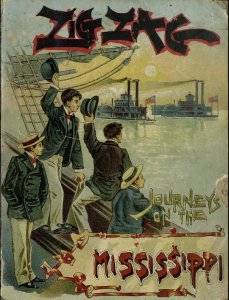 and spelling books, fairy tales, codes of conduct, and, especially, adventure stories—pre-Hardy Boys and Nancy Drew examples of what we would call young adult fiction, these published principally for boys. Adventure stories offered a (very colonialist) view of the wide world; in series like the Boston-published Zig Zag and English books like Afloat with Nelson, both from the 1890s, fact mingled with fiction, natural history and science with battle and travel accounts. But there is another distinctive strain in the children’s literature of the time, one which to us—but not necessarily to the Victorians—would seem contrary to the imperialist young adult novel.
and spelling books, fairy tales, codes of conduct, and, especially, adventure stories—pre-Hardy Boys and Nancy Drew examples of what we would call young adult fiction, these published principally for boys. Adventure stories offered a (very colonialist) view of the wide world; in series like the Boston-published Zig Zag and English books like Afloat with Nelson, both from the 1890s, fact mingled with fiction, natural history and science with battle and travel accounts. But there is another distinctive strain in the children’s literature of the time, one which to us—but not necessarily to the Victorians—would seem contrary to the imperialist young adult novel.
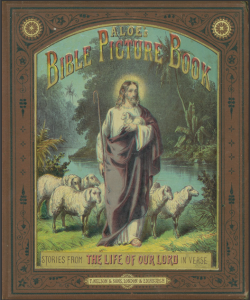 For most Victorian students and readers, poetry was a daily part of life, and it was a central instructional and storytelling form in children’s lit. The A.L.O.E.’s Bible Picture Book from 1871, above, presents “Stories from the Life of Our Lord in Verse,” written “simply for the Lord’s lambs, rhymes more readily than prose attracting the attention of children, and fastening themselves on their memories.” Children and adults regularly memorized poetry, after all. Yet after the explosion in children’s publishing the former readers were often given inferior examples of it. The author of the Bible Picture Book admits as much, begging the indulgence of older readers in the preface for “defects in my work,” given that “the verses were made for the pictures, not the pictures for the verses.”
For most Victorian students and readers, poetry was a daily part of life, and it was a central instructional and storytelling form in children’s lit. The A.L.O.E.’s Bible Picture Book from 1871, above, presents “Stories from the Life of Our Lord in Verse,” written “simply for the Lord’s lambs, rhymes more readily than prose attracting the attention of children, and fastening themselves on their memories.” Children and adults regularly memorized poetry, after all. Yet after the explosion in children’s publishing the former readers were often given inferior examples of it. The author of the Bible Picture Book admits as much, begging the indulgence of older readers in the preface for “defects in my work,” given that “the verses were made for the pictures, not the pictures for the verses.”
This is not an author, or perhaps a type of literature, one might suspect, that thinks highly 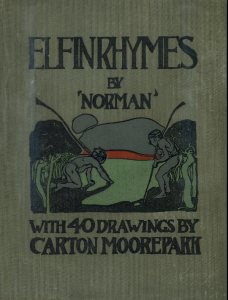 of children’s aesthetic sensibilities. We find precisely the opposite to be the case in the wonderful Elfin Rhymes from 1900, written by the mysterious “Norman” with “40 drawings by Carton Moorepark.” Whoever “Norman” may be (or why his one-word name appears in quotation marks), he gives his readers poems that might be mistaken at first glance for unpublished Christina Rossetti verses; and Mr. Moorepark’s illustrations rival those of the finest book illustrators of the time, presaging the high quality of Caldecott Medal-winning books of later decades. Elfin Rhymes seems like a rare oddity, likely published in a small print run; the care and attention of its layout and design shows a very high opinion of its readers’ imaginative capabilities.
of children’s aesthetic sensibilities. We find precisely the opposite to be the case in the wonderful Elfin Rhymes from 1900, written by the mysterious “Norman” with “40 drawings by Carton Moorepark.” Whoever “Norman” may be (or why his one-word name appears in quotation marks), he gives his readers poems that might be mistaken at first glance for unpublished Christina Rossetti verses; and Mr. Moorepark’s illustrations rival those of the finest book illustrators of the time, presaging the high quality of Caldecott Medal-winning books of later decades. Elfin Rhymes seems like a rare oddity, likely published in a small print run; the care and attention of its layout and design shows a very high opinion of its readers’ imaginative capabilities.
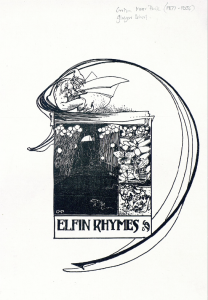 This title is representative of an emerging genre of late Victorian children’s literature, which still tended on the whole, as it does now, to fall into the trite and formulaic. Elfin Rhymes sits astride the fantasy boom at the turn of the century, heralded by hugely popular books like Frank L. Baum’s Wizard of Oz series and J.M. Barrie’s Peter Pan. These, the Harry Potters of their day, made millions of young people passionate readers of modern fairy tales, representing a slide even further away from the once quite narrow, “remorselessly instructional… or deeply pious” categories available in early writing for children, as Grenby points out.
This title is representative of an emerging genre of late Victorian children’s literature, which still tended on the whole, as it does now, to fall into the trite and formulaic. Elfin Rhymes sits astride the fantasy boom at the turn of the century, heralded by hugely popular books like Frank L. Baum’s Wizard of Oz series and J.M. Barrie’s Peter Pan. These, the Harry Potters of their day, made millions of young people passionate readers of modern fairy tales, representing a slide even further away from the once quite narrow, “remorselessly instructional… or deeply pious” categories available in early writing for children, as Grenby points out.
Where the boundaries for kids’ literature had once been 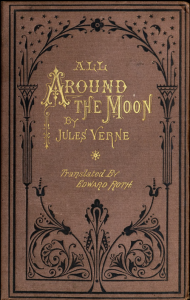 narrowly fixed by Latin grammar books and Pilgrim’s Progress, by the end of the 19th century, the influence of science fiction like Jules Verne’s, and of popular supernatural tales and poems, prepared the ground for comic books, YA dystopias, magician fiction, and dozens of other children’s literature genres we now take for granted, or—in increasingly large numbers—we buy to read for ourselves. Enter the Baldwin Library of Historical Children’s Literature here, where you can browse several categories, search for subjects, authors, titles, etc, see full-screen, zoomable images of book covers, download XML versions, and read all of the over 6,000 books in the collection with comfortable reader views. Find more classics in our collection, 800 Free eBooks for iPad, Kindle & Other Devices.
narrowly fixed by Latin grammar books and Pilgrim’s Progress, by the end of the 19th century, the influence of science fiction like Jules Verne’s, and of popular supernatural tales and poems, prepared the ground for comic books, YA dystopias, magician fiction, and dozens of other children’s literature genres we now take for granted, or—in increasingly large numbers—we buy to read for ourselves. Enter the Baldwin Library of Historical Children’s Literature here, where you can browse several categories, search for subjects, authors, titles, etc, see full-screen, zoomable images of book covers, download XML versions, and read all of the over 6,000 books in the collection with comfortable reader views. Find more classics in our collection, 800 Free eBooks for iPad, Kindle & Other Devices.
“Reprinted from Open Culture: The Best Free Cultural & Educational Media on the Web. Article by Josh Jones, August 30, 2016.”
